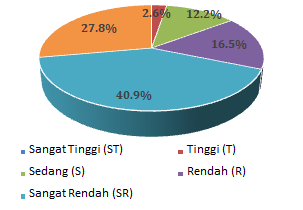Waste Konstruksi: Identifikasi Potensi dan Penyebabnya Pada Proyek Perumahan Di Pekanbaru
Construction Waste: Identification of Potential and Its Causes in Housing Project in Pekanbaru
DOI:
https://doi.org/10.25299/saintis.2019.vol19(2).3904Keywords:
waste, identifikasi, penyebab waste, perumahan, fishbone diagramAbstract
[ID] Waste merupakan salah satu penyebab rendahnya produktivitas. Besarnya potensi waste tentu saja akan merugikan owner ataupun kontraktor. Waste pada industri perumahan dapat mempengaruhi nilai jual rumah itu sendiri. Potensi waste material yang muncul pada proses pembangunan, penting untuk diidentifikasi dan dicari penyebabnya. Tujuan dari penelitian ini adalah mengidentifikasikan waste pada industri konstruksi (proyek perumahan) beserta sumber penyebab waste tersebut. Penelitian bersifat kuantitative dan data primer dikumpulkan dengan bantuan instrument kuesioner. Responden yang terlibat seluruhnya adalah pengawas lapangan/penanggung jawab lapangan proyek perumahan. The Statistical Package for Social Sciences (SPSS) dan fishbone diagram digunakan sebagai alat analisis variable dan indikator penyebab waste. Secara keseluruhan, hasil identifikasi penelitian menunjukkan bahwa material yang berpotensi ditemui pada proyek pembangunan perumahan di Pekanbaru yaitu material kayu dan batu bata (berpotensi sedang), material keramik, genteng, besi beton, cat, tanah, batu, pasir dan plesteran (berpotensi rendah) dan, cardboard packaging, plastic, kaca, metal, aspal dan plafond (berpotensi sangat rendah). Terdapat beberapa variable penyebab waste. Variabel-variabel tersebut terkait dengan sumber daya yang dibutuhkan selama proses pengerjaan proyek. Sumber penyebab waste yang berkonstribusi selama proses produksi secara signifikan dipengaruhi oleh variable: alat/mesin sebesar 0.885, metode kerja sebesar 0.873, material sebesar 0.866, manpower sebesar 0.821, dan lingkungan sebesar 0.808. Satu sumber variable dapat mempengaruhi variable yang lain, sehingga sangat penting untuk memperhatikan penyebab waste agar produktivitas pekerjaan dilapangan tidak terganggu.
[EN] Waste is one of the causes of low productivity. The potential of waste will certainly harm the owner or contractor. Waste in housing industry can affect the sale price of the house. The potential of material waste in construction process is important to identify and need to find its cause. The purpose of this study is to identify waste in the construction industry (housing project) along with the source of the cause of the waste. Quantitative research is conducted and primary data were collected with questionnaire as the instrument. All respondents involved were supervisor. The Statistical Package for Social Sciences (SPSS) and fishbone diagrams are used as a tool for analyzing variables and indicators of the causes of waste. Overall, the result of research identification shows that the potential material in housing construction projects in Pekanbaru, namely wood and brick material (medium potential), ceramic, roof tile, steel, paint, soil, stone, sand and plastering (low potential) and, cardboard packaging, plastic, glass, metal, asphalt and ceiling (very low potential). There are several variables that cause waste. These variables are related to the resources that needed during the construction process. The sources of waste causes that contribute during the production process are significantly influenced by variables, i.e. tools / machines at 0.885, work methods at 0.873, materials at 0.866, manpower at 0.821, and the environment at 0.808. One source of variables can affect other variables, so it is necessary to pay attention to the waste causes so that work productivity uninterrupted.
Downloads
References
[2] A. Mossman, “Creating value: A sufficient way to eliminate waste in lean design and lean production,” Lean Constr. J., vol. 2009, pp. 13–23, 2009.
[3] I. P. A. Wiguna, “Analisis Penanganan Material Waste Pada Proyek Perumahan Di Surabaya,” Semin. Nas. Apl. Teknol. Prasarana Wil., pp. 147–154, 2009.
[4] A. Asnudin, “Pengendalian Sisa Material Konstruksi Pada Pembangunan Rumah Tinggal,” J. Mek. Tek., vol. 12, no. 3, pp. 162–164, 2010.
[5] F. M. D. Setyanto. E., Kaming. P. F., “Studi Sisa Material Pada Proyek Gedung Dan Perumahan,” Konf. Nas. Tek. Sipil 4 (KoNTekS 4), vol. 4, no. KoNTekS 4, pp. 235–243, 2010.
[6] P. V. Sáez, M. Del Río Merino, C. Porras-Amores, and A. S. A. González, “Assessing the accumulation of construction waste generation during residential building construction works,” Resour. Conserv. Recycl., vol. 93, no. 2014, pp. 67–74, 2014.
[7] S. Dinesh, R. Sethuraman, and S. Shivaprakasam, “the Review on Lean Construction an Effective Approach in Construction,” Int. J. Eng. Res. Mod. Educ., vol. Special is, no. April, pp. 119–123, 2017.
[8] Lean Construction Institute, “Pengertian & Fokus Pilar Lean Construction.” [Online]. Available: https://leanconstructionindonesia.com/2018/08/27/pengertian-fokus-pilar-lean-construction/.
[9] H. K. Mohajan, “Two Criteria for Good Measurements in Research: Validity and Reliability,” Ann. Spiru Haret Univ. Econ. Ser., vol. 17, no. 4, pp. 59–82, 2017.
[10] I. Ghozali, Aplikasi multivariate program SPSS. 2009.
[11] S. Tumpal JR Sitinjak, Lisrel. Graha Ilmu, 2006.
[12] J. Sarwono, Metode Penelitian Kuantitatif & Kualitatif, Pertama. Yogyakarta: Graha Ilmu, 2006.
[13] Elizar, M. A. Wibowo, and P. Koestalam, “Identification and analyze of influence level on waste construction management of performance,” Procedia Eng., vol. 125, pp. 46–52, 2015.

Downloads
Published
Issue
Section
License

This work is licensed under a Creative Commons Attribution-ShareAlike 4.0 International License.
Copyright. This is an open access article which means that all content is freely available without charge to the user or his/her institution. Jurnal Saintis allows the author(s) to hold the copyright without restriction. The copyright in the text of individual articles (including research articles, opinion articles, and abstracts) is the property of their respective authors distributed under the terms of the Creative Commons Attribution-ShareAlike 4.0 International License which permits unrestricted use, distribution, and reproduction in any medium. Users are allowed to read, download, copy, distribute, search, or link to full-text articles in this journal without asking by giving appropriate credit, provide a link to the license, and indicate if changes were made.





